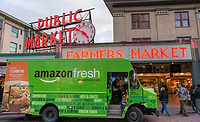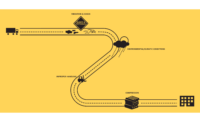The future of package delivery is drones. At least that’s what electric truck and drone maker Workhorse believes.
The company, which makes the drones under its HorseFly brand, partnered with PMMI to set up a drone delivery demonstration during the recent Pack Expo Las Vegas show. The event, which featured the actual drones lifting off of an electrical truck and then delivering a small package at a model home or hospital, was a peek into a possible future.
Elliot Bokeno, engineering project manager for Workhorse, says they envision the drones as being an extension of the truck, which can deliver packages in tandem.
“So we could send the drone to do one package while the driver’s doing other packages, eliminating the need to drive extra miles,” he explains.
Indeed, the presentation at Pack Expo was called, “Drone Demo - Packaging for the Last Mile.” During that demonstration, the drone delivered to a model home, slowly lowering the package with a retractable string so that it didn’t accidentally fall on any children or animals. For the other delivery, the drone went to a model hospital that featured a helipad where the drone was able to just lower down to the ground to deliver the box.
The drones have a 30-minute battery life and can recharge when docked on an electrical truck. They also have a top speed of 55 mph, but typically fly between 25-35 mph, and are usually flown about 200-400 ft. in the air.
“Honestly, by the time these things get about 100 ft. in the air you no longer notice them,” Bokeno says. “Really they don’t look like much more than a bird at that point. We want to fly at an altitude where we’re safe and away from any tree and telephone poles.”
The drones also are able to carry small packages that weigh up to 10 pounds, and the company is able to sort the packages on a truck into those that the drone is able to deliver and those it is not, and then tell the driver the most efficient ways to divide those packages up.
It’s a system that would have a huge impact on rural delivery.
“You have more driven miles per package that you’re delivering there than you do in the city,” Bokeno says. “One mile in New York of driving could be several hundred packages, one mile of driving in the country is like maybe one package.”
Bokeno says Workhorse believes the delivery model is more realistic than other drone concepts currently being discussed, such as the ones Amazon has been testing.
“The Amazon solution is where you have drones delivering packages, but there’s just hundreds of them that fly out of a warehouse,” he says. “You would need a warehouse in every suburb of the country to try to begin to blanket it. Whereas these fleets of trucks like this, already exist. They’re on your street every single day. It’s just a potential add-on to that fleet, we see it as being a more realistic way to get the drone delivery concept into the real world faster.”
So when exactly will these drones be flying in the real world? Well that depends on the Federal Aviation Administration. The FFA currently limits drone use to line-of-sight flights, but these would need an exception to that. But Workhorse already is working to get approval for that.
“We did a demonstration with UPS back in February that demonstrated the technology. We followed all the FFA guidelines for what was allowed at the time,” Bokeno says. “So right now to fully unleash what this technology is able to do, we need to fly the drones beyond line of sight of the driver that launches it.”
The company is hoping to get approval to conduct more studies by the end of the year. And if all goes well, drone delivery soon could be commonplace.
“From there, we’re at the place where we could go and deliver real packages with these drones, and confidentially say, ‘When I launch from the truck that it’s going to go where it needs to go and drop off and come back,’” he says.
For more information: Visit workhorse.com.



